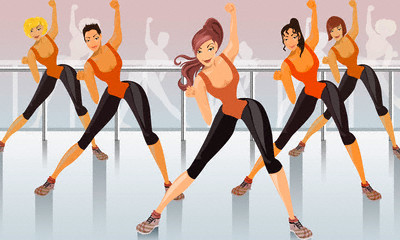| Self Defense |
Volleyball |
Bowling |
Aerobics |
| Why Teach Self Defense |
History of Self Defense |
Guidelines |
 This picture illustrates Self defense in a Physical Education setting. |
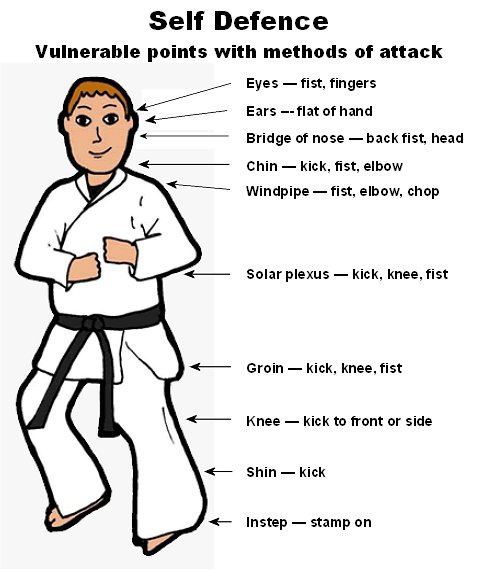 |
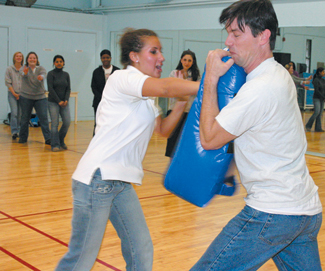 This shows how you can teach self defense using props for a more hands on understanding. |
Why teach self defense in a Physical Education Environment?
Affective Development. A primary aspect of self-defense instruction is the development of self-confidence in participants (Chen, 1998). Self-defense students are continually challenged to face their fears, consider appropriate alternatives to physical violence, and work together to increase skill, knowledge, and learning. These teaching points all lead to self-confidence, which has always been a highly cherished value of education. Respect for oneself and others through physical movements and cognitive concepts may further enhance the development of self-efficacy in each student. The opportunity to encourage the development of the affective domain through self-defense instruction cannot be underestimated.
Cognitive Development. It has been said that the best way to avoid negative or unwanted situations is to limit exposure to an environment where these situations are likely to occur. Hence, the concept that personal self-defense consists primarily of thinking, using sound judgment, and developing premeditated action plans should be considered when designing the cognitive component of a self-defense instructional unit. Nonphysical conflict resolution techniques should be taught in terms of recognizing, preventing, avoiding, and deterring potentially harmful situations. For example, an examination of situational awareness, or the individual's ability to pay attention to the details surrounding oneself in any environment, could easily be a part of this cognitive approach.
Works Cited:
http://goliath.ecnext.com/coms2/gi_0199-2495401/Applying-mass-media-to-self.html
History
of Self Defense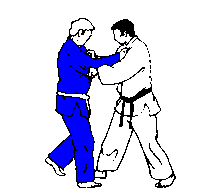 |
There is no true origin of self defense considering
that due to nature people possess their own natural defenses. Self
defense was evident in prehistoric times when primates were often
observed using tools such as sticks to beat the
brush to scare potential predators and chase out their prey. They are
also known to throw rocks and dirt in the faces of their opponents when
fighting over a mate. It is this use of tools rather than simply teeth
and claws that set them apart from other animals who rely on instinct
rather than intelligence during
combat.
Human forms of defense surely originate and follow a
similar path. From the time the first prehistoric human threw a rock,
used a stick or even a fist to defend him, and systemization forms of
combat began to be formed.
While there have been many events and occurrences
that have marked major turning points in the evolution of the martial
arts, credit for their creation can not be given to any one person or
group of persons. Due to their turbulent past, extreme levels of
nationalistic pride lost or destroyed documents and the earlier oral
traditions of the martial arts, a completely accurate account of the
martial arts history will never be known. Even today many martial arts
masters, historians and scholars differ, sometimes greatly, as to the
true history of the various arts. They are ever evolving systems of
combat and defense with the ultimate goal of mental and spiritual
cultivation. However, the highest levels of martial arts evolution can
be seen in the Asian martial arts, which have developed into much more
than a simple collection of fighting techniques. They have become a
science, an art and a philosophy.
Historically there are three main branches of Asian
martial arts, Tribal, Religious and Royal Court. Tribal martial arts
are the oldest forms and were passed mostly through family or village
lines. Buddhist monks and Taoist sages used religious martial arts not
only as combat and defense, but also as a means of spiritual
cultivation and enlightenment. Most of the philosophies of compassion
and non-violence, present in today’s martial arts come from these
systems. The third branch is the Royal Court martial arts, Emperor’s
guard and the warriors of royalty used these forms of martial arts. It
is within these forms of martial arts that the advanced techniques of
seizing and controlling opponents that you will learn today were
developed.
Today the martial arts have developed even further.
With the introduction of advanced science and deeper understanding of
the human body, they can be seen in a much more logical and complete
manner. Unfortunately most styles of martial arts still only teach
endless combinations of techniques from an endless list of situations.
In order to understand the martial arts completely, you must understand
not only the techniques but also more importantly the theories and
principles behind them.
|
Works Cited: Self Defense Guidelines |
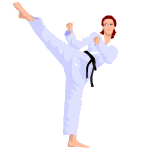 |
You have the right to use reasonable
force to prevent a crime including defending yourself against an attack
or a perceived attack - the latter point is critical:
-
you only have to think you are about to be attacked
to be able to defend yourself
-
even if you ‘attacker’ later claims that they were
only fooling around.
Note
that you may have to stand up in court and justify your actions - any unnecessary force, especially which results in
injury, leaves you open to liability.
- do as much as you can to avoid a
confrontation
- be
aware of your surroundings, e.g. are there places where an attacker may
be hiding such as bushes in parks, alleyways, doorways, etc.
- avoid
areas where there may be danger, e.g. keep to well lighted and busy
areas at night even if it means taking a longer route – even when you
are driving a car.
If
you get caught up in a situation
- try
to talk to an aggressor without provoking them.
- practice
relaxation - appearing fearful or stressed can actually provoke an
attack.
- don’t
be aggressive as this can provoke an attack.
- attempt to maintain a comfortable distance
between you and the aggressor.
- if someone attempts to grab your bag or anything
else, it may be best to let them take it rather than risk confrontation
or injury.
- scream,
shout or use an attack alarm, disorientating an attacker, giving you
enough time to run away; shouting ‘fire’ rather than ‘help’ can get
more results.
- panic can disable you
- adopt
what police term the "bash and dash" approach, i.e. stun your attacker
to the point where you can run away
- you
may use items such as bags, umbrellas, keys, etc.
- don't
carry or use anything that the law would regard as an offensive weapon.
Once
you've have stunned your attacker, get away as fast as you can!
- do
not attack them, e.g. to ‘teach the attacker a lesson”
- you could be putting yourself in more danger
(they may recover or have friends) or you could end up being charged
with assault.
www.cse.dmu.ac.uk/
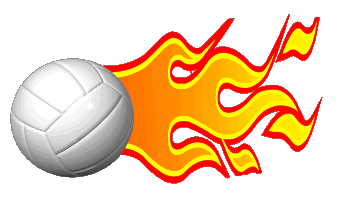 |
| Important
Time Line of Specific Volleyball Events |
Rules of the
Game |
Court Dimensions |
|
A TIME LINE OF SIGNIFICANT VOLLEYBALL EVENTS. In 1900, a special ball was designed for the sport. In 1916, in the Philippines, an offensive style of passing the ball in a high trajectory to be struck by another player (the set and spike) were introduced. In 1917, the game was changed from 21 to 15 points. In 1920, three hits per side and back row attack rules were instituted. In 1922, the first YMCA national championships were held in Brooklyn, NY. 27 teams from 11 states were represented. In 1928, it became clear that tournaments and rules were needed, the United States Volleyball Association (USVBA, now USA Volleyball) was formed. The first U.S. Open was staged, as the field was open to non-YMCA squads. In 1930, the first two-man beach game was played. In 1934, the approval and recognition of national volleyball referees. In 1937, at the AAU convention in Boston, action was taken to recognize the U.S. Volleyball Association as the official national governing body in the U.S. In 1947, the Federation Internationale De Volley-Ball (FIVB) was founded. In 1948, the first two-man beach tournament was held. In 1949, the initial World Championships were held in Prague, Czechoslovakia. In 1964, Volleyball was introduced to the Olympic Games in Tokyo. In 1965, the California Beach Volleyball Association (CBVA) was formed. In 1974, the World Championships in Mexico were telecast in Japan. In 1975, the US National Women's team began a year-round training regime in Pasadena, Texas (moved to Colorado Springs in 1979, Coto de Caza and Fountain Valley, CA in 1980, and San Diego, CA in 1985). In 1977, the US National Men's team began a year-round training regime in Dayton, Ohio (moved to San Diego, CA in 1981). In 1983, the Association of Volleyball Professionals (AVP) was formed. In 1984, the US won their first medals at the Olympics in Los Angeles. The Men won the Gold, and the Women the Silver. In 1986, the Women's Professional Volleyball Association (WPVA) was formed. In 1988, the US Men repeated the Gold in the Olympics in Korea. In 1990, the World League was created. In 1995, the sport of Volleyball was 100 years old! In 1996,
2-person beach volleyball will be an Olympic Sport. Works Cited: |
 |
Rules of the Game
THE SERVE
- Server must serve from behind the restraining line ( end line ) until after contact.
- Ball may be served underhand or overhand.
- Ball must be clearly visible to opponents before serve.
- Served ball may graze the net and drop to the other side for point.
- First game serve is determined by a volley, each subsequent game shall be served by the previous game loser.
- Serve must be returned by a bump only. no setting or attacking a serve.
SCORING
- Rally scoring will be used.
- There will be a point scored on every score of the ball.
- Offense will score on a defense miss or out of bounds hit.
- Defense will score on an offensive miss, out of bounds hit, or serve into the net.
- Game will be played to 25 pts.
- Must win by 2 points.
ROTATION
|
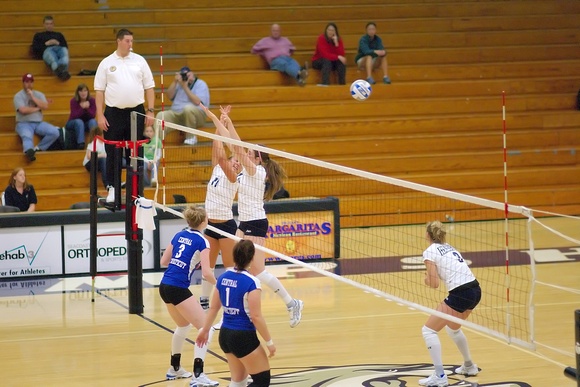 This picture shows a highschool varsity game |
PLAYING
THE GAME
- Maximum of three hits per side.
- Player may not hit the ball twice in succession ( A block is not considered a hit ).
- Ball may be played off the net during a volley and on serve.
- A ball touching a boundary line is good.
- A legal hit is contact with the ball by a player body above and including the waist which does not allow the ball to visibly come to a rest.
- If two or more players contact the ball simultaneously, it is considered one play and the players involved may not participate in the next play.
- A player must not block or attack a serve.
- Switching positions will be allowed only between front line players. ( After the serve only ).
BASIC VIOLATIONS
- Stepping on or over the line on a serve.
- Failure to serve the ball over the net successfully.
- Hitting the ball illegally ( Carrying, Palming, Throwing, etc. ).
- Touches of the net with any part of the body while the ball is in play. If the ball is driven into the net with such force that it causes the net to contact an opposing player, no foul will be called, and the ball shall continue to be in play.
- Reaching over the net, except under these conditions:
- When executing a follow-through.
- When blocking a ball which is in the opponents court but is being returned ( the blocker must not contact the ball until after the opponent who is attempting to return the ball makes contact). Except to block the third play.
- Reaches under the net ( if it interferes with the ball or opposing player ).
- Failure to serve in the correct order.
- Blocks or spikes from a position which is clearly not behind the
10-foot line while in a back row
position.http://westlake.k12.oh.us/hilliard/whspe/volleyball/volleyball_rules.htm
Court Dimensions
| Volleyball
Court Dimensions
Overall Dimensions |
 |
The overall measurements for a Volleyball court is 60 feet by 30 feet. Each side of the court is therefore 30 feet by 30 feet in size.
Center Line
A center line is marked at the center of the court dividing it equally into 30 feet squares.
Attack Line
The attack line is marked 10 feet on each side of the center line of the court. Some rules show the attack line at 9' 10" however that includes the width of the line itself (2").
Service Line
A service line is marked 10 feet inside the right sideline on each back line. This is the area from which the server may serve the volleyball.
The Net
The net is hung directly above the center line at 7 feet 4 inches for women and 8 feet for men.
Standards
Volleyball standards should be set at 36 feet apart, 3 feet on either side of the sidelines.
Ceiling Height
The minimum ceiling height should be 23 feet. Preferably the ceilings should be higher.
Works Cited:
http://www.basketball-goals.com/volleyball-court-dimensions.htm
| History of Bowling |
Bowling Terminology |
Basic Rules |
| History The history of bowling can be traced back to the Stone Age. The first evidence of the game was discovered by the British Anthropologist Sir Flinders Petrie and his team of archaeologists in Egypt in the 1930s. He unearthed a collection of objects from a small child?s grave that appeared to have been the primitive form of the game. However, some argue that the game evolved much later than that. William Pehle, a German historian, claimed that the game of bowling originated in Germany around 300 AD. In Germany, the game had its origin as a religious ceremony for determining absence of sin. This game, introduced by the German monks to the masses, flourished as a customary test of faith. In England, bowling was started as early as the 1100s. Throughout England, several variations of bowling, such as half-bowls, skittles and ninepins, existed during the mid 1300s. But, the first written mention of the game was made by the King Edward III in the year 1366. In this reference, he allegedly imposed a ban on playing this game among his troops because it was distracting the troops from archery practice. Later, during the regime of King Henry VIII, the game gained popularity and was played as a symbol of nobility and social status. Bowling has been popular in America since Colonial days. During 17th century, English, Dutch and German settlers imported their own version of bowling to America. At that time, the game consisted of nine pins which were regularly played in an area of New York City still known as "Bowling Green". Connecticut banned ninepins in 1841 because of their gambling implications. The American Bowling Congress was formed on 9 September 1895 and is credited with standardizing bowling in the United States and organizing official competition. The Women's Bowling League followed in 1917, under the encouragement of proprietor Dennis Sweeny. Through the years, the game has
changed. A variety of tactics have been developed. The invention of
automatic pinspotter in the 1940s revolutionized both the bowling game
and industry. Currently, the sport of bowling is enjoyed by 95 million
people in more than ninety countries worldwide. Works Cited: |
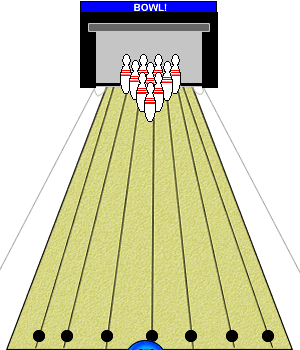 |
- Approach - The area at least 15' long, on which the player
walks to the foul line. Usually adjacent to the ball returns and has
spots embedded in the approach to aid in lining up.
- Backswing - The path of the arm behind the body during the
next to last step in the delivery.
- Channel or gutter - There are 2 channels on each side of
the lane. Once a ball falls into the channel or gutter before hitting
pins, the bowler shall receive a zero.
- Count - The number of pins knocked down on the first ball.
- Foul - Touching or going beyond the foul line.
- Frame - One-tenth of a game. Each square on score sheet is
one frame.
- Gutter ball - Delivery which rolls off the lane into the
gutter.
- Hook - A ball that breaks sharply toward the pocket.
- Leave - Pins remaining after the first delivery.
- Pocket - Area between 1-2 pins for a lefty and 1-3 pins for
a right hander.
- Spare - Knocking down all remaining pins in the second ball
or delivery.
- Strike - Knocking down all ten pins with the first ball or
delivery.
- Target Arrows - Sighting targets embedded in the lane to
help the player align start position. Usually 15' down the lane from
the foul line.
- Track - Path to the pins created by many balls rolled in the same general area
http://www.glacierlanes.com/pro-shop/bowling-terminology.htm
Basic Rules
A game of bowling consists of ten frames. In each frame, the bowler will have two chances to knock down as many pins as possible with their bowling ball. In games with more than one bowler, as is common, every bowler will take their frame in a predetermined order before the next frame begins. If a bowler is able to knock down all ten pins with their first ball, he or she is awarded a strike. If the bowler is able to knock down all 10 pins with the two balls of a frame, it is known as a spare. Bonus points are awarded for both of these, depending on what is scored in the next 2 balls (for a strike) or 1 ball (for a spare). If the bowler knocks down all 10 pins in the tenth frame, the bowler is allowed to throw 3 balls for that frame. This allows for a potential of 12 strikes in a single game, and a maximum score of 300 points, a perfect game.
Works Cited:http://en.wikipedia.org/wiki/Ten-pin_bowling#Rules_of_play
Importance of Aerobics
Aerobic exercise is a great workout that not only helps in maintaining your fitness level, but also makes your heart stronger. There are distinct forms of aerobics like cycling, biking, jogging, running, swimming, dancing etc.
There are innumerable health benefits of aerobics like it helps in utilizing oxygen more efficiently, thereby paving way for increased fat burning. The chances of having diabetes and other diseases are largely reduced. If you are keeping unwell, then aerobics exercise can help you a great deal in faster recovery. Aerobic also acts as a fantastic stress reliving therapy. Thus, it can be said that it helps to maintain your overall fitness, on one hand it enables you to have a beautiful fit body and on the other hand, it ensures that your mind remains stress free.
Aerobic fitness is a very important factor in growth and development during childhood and adolescence. It is also an important factor in the aging process. A high level of aerobic fitness during the growing years indicates good development of the muscles, bones, and cardiorespiratory system.
Benefits of aerobic exercise include the following:
- Lowering of high blood pressure.
- Increasing the high density lipoprotein (HDL) in the blood which helps collect the cholesterol in the blood and dispose of it in the liver.
- Lowering the plasma triglyceride levels (fatty substances).
- Assisting in weight control, mainly by reducing body fat.
- Improving the function of the heart, by promoting beneficial changes in the structure and function of the coronary arteries (which provide oxygen to the heart muscle.
- Alleviating muscle pain and improving walking capability in people who suffer from peripheral arterial disease.
- Reduction in the rate of occurrence of various types of cancer involving the colon, breast, prostate, and lungs.
- Assistance in the prevention of osteoporosis (loss in bone mineral density).
- Prevention of lower back pain. Reduction in the incidence of stroke.
- Improvement in the functioning of the immune system.
- Decreasing the insulin requirement and improving glucose control in Type 1 (insulin dependent) diabetes; preventing the development of Type 2 (non-insulin dependent) diabetes, and improving glucose tolerance if this condition exists.
- Strengthening of muscles, ligaments, tendons, and joints.
- Assistance in the control of joint pain and swelling in people who suffer from arthritis.
- Improving temperature regulation at rest and during exercise in different environments.
- Improving blood pressure control, and minimizing fainting in people who are prone to this condition.
http://www.aerobictest.com/AerobicFitnessImportance.htm
http://www.iloveindia.com/fitness/aerobics/index.html
Dance Aerobics
| Aerobic dance is a fun way to get fit. It combines fat-burning aerobic movements, muscle-building exercises, and stretching into routines that are performed to music. Many dance forms are used, including disco, jazz, hip-hop, step, and ballet. All ages can benefit from aerobic dance. While participating in dance aerobics various forms of physical activity are intertwined so that all areas of your body are getting a great workout. | 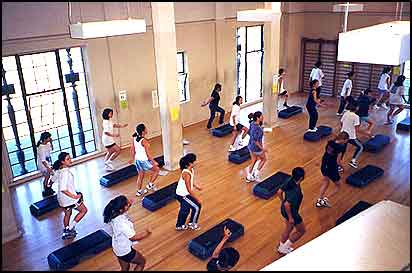 This
picture shows a dance/step aerobics class.
|
Aerobic dance classes are usually offered at three levels
of intensity. A low-impact class is conducted at a slower pace and is
easier to do. It is good for people just starting an exercise program.
This level is not active enough to improve the efficiency of the heart
and lungs in people who are already fit. In the intermediate classes,
dancers benefit their heart and lungs as they gain overall strength and
flexibility. The advanced classes, also called high-impact, are for fit
people who want a hard workout.
Works Cited:
http://www.baptistonline.org/health/library/exer3096.asp
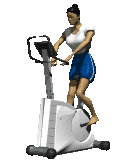 |
Your local gym will provide a wide variety
of aerobic options, such as treadmills, cross trainers, exercise bikes,
stair masters, rowing and ski machines so that you can just switch on
and get started with your workout. It can be a good idea to diversify
between different machines and different speeds/levels of resistance as
your body can get used to a certain routine and after a number of
sessions the same routine will not work your heart and lungs as much as
it once did. For those who prefer to work out as part of a group, many gyms provide classes, such as various forms of dance, body pump, body combat and step aerobics with a trained instructor to ensure that you get the most out of your workout. If you have access to a pool, swimming is also a very effective cardiovascular activity. As it is very low impact it is often suitable for people who have had injuries or problems with muscles or joints; this is considered water aerobics. |
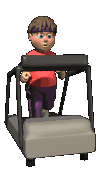 |
This page was designed and published by Jessica Ricotta and is solely responsible for its contents.
Last updated May 8, 2008

